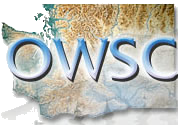High Mortality of Cassin’s Auklets in the Pacific NW During the Winter of 2014-15
The waters off the coast of the Pacific Northwest have been unusually warm during the last couple of years, and this has had widespread and major impacts on the marine ecosystem. One of the more notable and publicized effects has been a harmful algal bloom (HAB) of unprecedented geographic scope, duration, and intensity. Here we will focus on a different sort of impact, and that is a Cassin’s auklet mortality event that occurred during the winter of 2014-15, as revealed by observations collected by the Coastal Observation and Seabird Survey Team (COASST). This mortality event provides clues about the recent state of the regional ocean because seabirds can be effective sentinels for the marine ecosystem.
COASST is a citizen science project organized by the University of Washington under the leadership of Prof. Julia Parrish. It features data collected by trained coastal residents of three types: beached birds, marine debris, and evidence of human impacts on the beach environment. It has been in existence for 17 years and is accumulating valuable time series for evaluating variations and trends in the coastal environment from Northern California to Alaska. It serves to provide not just unique data, but also promotes environmental stewardship through the regular interactions between citizens and scientists. Documenting the number and types of bird carcasses (sometimes called “wrecks”) while walking along the beach may not be everyone’s idea of a good time. Nevertheless, the experience from COASST is that its volunteers are generally very dedicated and thorough, resulting in high-quality data sets that can and have been subjected to rigorous scientific analysis. More information on COASST is available at the following website: http://depts.washington.edu/coasst/

Cassin’s auklet carcasses began appearing in large numbers on the beaches of the Pacific Northwest during October 2014 continuing into early 2015. Figure 1 shows the 53 individuals that were found on a single beach in Oregon during January 2015. It is not obvious from this photograph but these birds were generally emaciated. It bears emphasizing that these kinds of numbers are extraordinary. In past years, volunteers would generally encounter a dead Cassin’s auklet every few kilometers, but during the peak period of this event, on some surveys it was as frequently as every 10 meters! This is illustrated in a more quantitative way in Figure 2. The ratios of the encounter rates during the winter months of 2014-15 to those of the winter months of previous years are indicated by the areas of the reddish-brown circles relative to those of the blue circles. These ratios are stunning. Additional analysis based on the sampling protocol, and the proportions of birds that likely sunk at sea rather than washed up on beaches, suggests that this may have been the largest sea bird mortality event ever documented (J. Parrish, personal communication).

Why were there so many dead Cassin’s auklets on beaches during the winter of 2014-15? Variations in carcass counts occur for four basic reasons: (1) overall populations related to recent breeding success, (2) the weather in their foraging region (strong storms are associated with elevated mortality rates), (3) habitat expansion/contraction (birds dying nearer the coast are more likely to be beached), and (4) the availability of suitable prey/feeding conditions. During the winter of 2014-15, all of the factors except for (2) appear to have played a role. Regarding (1), there was enhanced breeding success in prior years, leading to a relatively high number of younger birds. With respect to (3), there was almost certainly compression of the suitable habitat for Cassin’s auklets due to water of more moderate temperatures near the coast. It is apparent, however, that the primary factor was the lack of food. Specifically, these birds target krill and other zooplankton, and to a certain extent forage fish, that are adapted to cooler water. These species were in short supply; the much warmer than normal water meant a preponderance of sub-tropical species at lower trophic levels that are generally less nutritious. This had implications not just for the Cassin’s auklets but rather for the entire ecosystem. For example, juvenile salmon prefer many of the same species, and the salmon that went to sea in 2015 found slim pickings. As a result, coho salmon returns in 2016 are expected to be lower than normal (http://www.nwfsc.noaa.gov/research/divisions/fe/estuarine/oeip/g-forecast.cfm).
Not surprisingly, the recent Cassin’s auklet mortality event is of considerable scientific interest, and a journal publication on it is being prepared by Julia Parrish and others. While upper ocean temperatures continue to be anomalously warm, global climate models are indicating a slow trend towards more normal physical conditions over the course of 2016. It will be interesting to see how the ecosystem responds and in particular whether there will be much in the way of prolonged effects to this recent extreme climate event.
